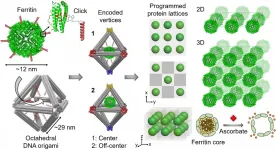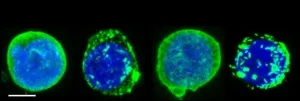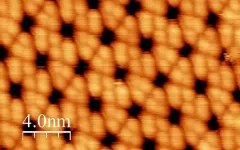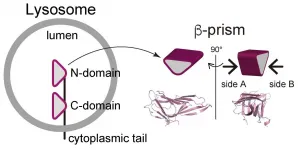(Press-News.org) UPTON, NY--Scientists have organized proteins--nature's most versatile building blocks--in desired 2-D and 3-D ordered arrays while maintaining their structural stability and biological activity. They built these designer functional protein arrays by using DNA as a programmable construction material. The team--representing the U.S. Department of Energy's (DOE) Brookhaven National Laboratory, Columbia University, DOE's Lawrence Berkeley National Laboratory, and City University of New York (CUNY)--described their approach in the June 17 issue of Nature Communications.
"For decades, scientists have dreamed about rationally assembling proteins into specific organizations with preserved protein function," said corresponding author Oleg Gang, leader of the Center for Functional Nanomaterials (CFN) Soft and Bio Nanomaterials Group at Brookhaven Lab and a professor of chemical engineering and of applied physics and materials science at Columbia Engineering. "Our DNA-based platform has enormous potential not only for structural biology but also for various bioengineering, biomedical, and bionanomaterial applications."
The primary motivation of this work was to establish a rational way to organize proteins into designed 2-D and 3-D architectures while preserving their function. The importance of organizing proteins is well known in the field of protein crystallography. For this technique, proteins are taken from their native solution-based environments and condensed to form an orderly arrangement of atoms (crystalline structure), which can then be structurally characterized. However, because of their flexibility and aggregation properties, many proteins are difficult to crystallize, requiring trial and error. The structure and function of proteins may change during the crystallization process, and they may become nonfunctional when crystallized by traditional methods. This new approach opens many possibilities for creating engineered biomaterials, beyond the goals of structural biology.
"The ability to make biologically active protein lattices is relevant to many applications, including tissue engineering, multi-enzyme systems for biochemical reactions, large-scale profiling of proteins for precision medicine, and synthetic biology," added first author Shih-Ting (Christine) Wang, a postdoc in the CFN Soft and Bio Nanomaterials Group.
Though DNA is best known for its role in storing our genetic information, the very same base-pairing processes used for this storage can be leveraged to construct desired nanostructures. A single strand of DNA is made of subunits, or nucleotides, of which there are four kinds (known by the letters A, C, T, and G). Each nucleotide has a complementary nucleotide it attracts and binds to (A with T and C with G) when two DNA strands are near each other. Using this concept in the technique of DNA origami, scientists mix multiple short strands of synthetic DNA with a single long strand of DNA. The short strands bind to and "fold" the long strand into a particular shape based on the sequence of bases, which scientists can specify.
In this case, the scientists created octahedral-shaped DNA origami. Inside these cage-like frameworks, they placed DNA strands with a particular "color," or coding sequence, at targeted locations (center and off center). To the surface of proteins--specifically, ferritin, which stores and releases iron, and apoferritin, its iron-free counterpart--they attached complementary DNA strands. By mixing the DNA cages and conjugated proteins and heating up the mixture to promote the reaction, the proteins went to the internal designated locations. They also created empty cages, without any protein inside.
To connect these nanoscale building blocks, or protein "voxels" (DNA cages with encapsulated proteins), in desired 2-D and 3-D arrays, second author and Columbia PhD student Brian Minevich designed different colors for the external bonds of the voxels. With this color scheme, the voxels would recognize each other in programmable, controllable ways leading to the formation of specifically prescribed types of protein lattices. To demonstrate the versatility of the platform, the team constructed single- and double-layered 2D arrays, as well as 3D arrays.
"By arranging the colors in a particular way, we can program the formation of different lattices," explained Gang. "We have full control to design and build the protein lattice architectures we want."
To confirm that the proteins had been encapsulated inside the cages and the lattices had been constructed as designed, the team turned to various electron- and x-ray-based imaging and scattering techniques. These techniques included electron microscopy (EM) imaging at the CFN; small-angle x-ray scattering at the National Synchrotron Light Source II (NSLS-II) Complex Materials Scattering (CMS) and Life Science X-ray Scattering (LiX) beamlines at Brookhaven; and cryogenic-EM imaging at the Molecular Foundry (MF) of Lawrence Berkeley and the CUNY Advanced Science Research Center. The CFN, NSLS-II, and MF are all DOE Office of Science User Facilities; CFN and MF are two of five DOE Nanoscale Science Research Centers.
"The science was enabled by advanced synthesis and characterization capabilities at three user facilities within the national lab system and one university-based facility," said Gang. "Without these facilities and the expertise of scientists from each of them, this study wouldn't have been possible."
Following these assembly studies, they investigated the biological activity of ferritin. By adding a reducing reagent to the ferritin lattice, they induced the release of iron ions from the center of the ferritin proteins.
"By monitoring the evolution of SAXS patterns during iron release, we could quantify how much iron was released and how quickly it was released, as well as confirm that the integrity of the lattice was maintained during this protein operation," said Minevich. "According to our TEM studies, the proteins remained inside the frames."
"We showed that the proteins can perform the same function as they do in a biological environment while keeping the spatial organization we created," explained Wang.
Next, the team will apply their DNA-based platform to other types of proteins, with the goal of building more complex, operational protein systems.
"This research represents an important step in bringing together different components from real biological machinery and organizing them into desired 2-D and 3-D architectures to create engineered and bioactive materials," said Gang. "It's exciting because we see the rational path for fabricating desired functional bio-nano systems never-before produced by nature."
INFORMATION:
This work was supported by the DOE Office of Science, a Laboratory Directed Research and Development Program grant, and the National Science Foundation. The LiX beamline is part of the Life Science Biomedical Technology Research resource, cofunded by the National Institute of General Medical Sciences and the DOE Office of Biological and Environmental Research, with additional support from the National Institutes of Health. Brookhaven's Biology Department supplied the proteins.
Brookhaven National Laboratory is supported by the U.S. Department of Energy's Office of Science. The Office of Science is the single largest supporter of basic research in the physical sciences in the United States and is working to address some of the most pressing challenges of our time. For more information, visit https://energy.gov/science.
Follow @BrookhavenLab on Twitter or find us on Facebook.
Scientists from within the Antibody and Vaccine Group at the University of Southampton have gained novel insights into how an important class of immune receptors called tumour necrosis factor receptors (TNFR) are activated.
The work, published in the journal Communications Biology, investigates a class of receptors present on immune cells called TNFR. These receptors, such as CD40, 4-1BB and OX40, are key in helping the immune system fight pathogens and cancer cells. Accordingly, antibody drugs which are designed to specifically target and activate these receptors (called ...
People with dementia receiving home health care visits are less likely to be readmitted to the hospital when there is consistency in nursing staff, according to a new study by researchers at NYU Rory Meyers College of Nursing. The findings are published in the journal Medical Care, a journal of the American Public Health Association.
Home health care--in which health providers, primarily nurses, visit patients' homes to deliver care--has become a leading source of home- and community-based services caring for people living with dementia. These individuals often have multiple chronic conditions, take several medications, and need assistance with activities of daily living. In 2018, more than 5 million Medicare beneficiaries received ...
COLUMBUS, Ohio - Although the United States is the only wealthy nation that doesn't guarantee paid leave to mothers or fathers after the arrival of a new child, Americans endorse providing paid time off for parents nearly as much as people from other countries.
About 82% of Americans support paid maternity leave, just slightly less than the 86% who support it in 26 wealthy nations, a new study shows.
Where Americans differ from the rest of the world is that they are less supportive of government funding for paid leaves, prefer shorter leave times and are less supportive of paid leave for fathers.
"We find marked differences in how Americans want paid leave administered compared ...
Singularities such as those at the centre of black holes, where density becomes infinite, are often said to be places where physics 'breaks down'. However, this doesn't mean that 'anything' could happen, and physicists are interested in which laws could break down, and how.
Now, a research team from Imperial College London and the Cockcroft Institute and Lancaster University have proposed a way that singularities could violate the law of conservation of charge. Their theory is published in Annalen der Physik.
Co-author Professor Martin McCall, from the Department of Physics at Imperial, said: "'Physics breaks down at a singularity' is one of the most famous statements in pop-physics. But by ...
To make computer chips, technologists around the world rely on atomic layer deposition (ALD), which can create films as fine as one atom thick. Businesses commonly use ALD to make semiconductor devices, but it also has applications in solar cells, lithium batteries and other energy-related fields.
Today, manufacturers increasingly rely on ALD to make new types of films, but figuring out how to tweak the process for each new material takes time.
Part of the problem is that researchers primarily use trial and error to identify optimal growth conditions. But a recently published study -- one of the first in this scientific field -- suggests that using artificial intelligence (AI) can be more efficient.
In the ACS Applied ...
ALBUQUERQUE, N.M. -- Like two superheroes finally joining forces, Sandia National Laboratories' Z machine -- generator of the world's most powerful electrical pulses -- and Lawrence Livermore National Laboratory's National Ignition Facility -- the planet's most energetic laser source -- in a series of 10 experiments have detailed the responses of gold and platinum at pressures so extreme that their atomic structures momentarily distorted like images in a fun-house mirror.
Similar high-pressure changes induced in other settings have produced oddities like hydrogen appearing as a metallic fluid, helium in the form of rain and sodium a transparent metal. But until now there has been no way to accurately calibrate these pressures and responses, the first step to ...
Tsukuba, Japan - Organic light-emitting diodes (OLEDs) are widely used in display technology and are also being investigated for lighting applications. A comprehensive understanding of these devices is therefore important if their properties are to be harnessed to their full potential. Researchers from the University of Tsukuba have directly observed the photoexcited electron dynamics in an organic film using time-resolved photoelectron emission microscopy. Their findings are published in Advanced Optical Materials .
OLED displays are popular because they are bright, lightweight, and do not consume a lot of power. Their output is generated when an exciton--a combination of an electron and an electron hole--releases its energy. However, this ...
Tokyo, Japan - A cell is composed of numerous organelles, each with a unique role that helps contribute to its overall functionality. The lysosome is an organelle that contains digestive enzymes and functions as a molecular garbage disposal and recycling center. Since the role of lysosome is crucial to maintain the cellular homeostasis, the lysosomal dysfunction causes neurodegenerative and metabolic diseases, cancer, as well as lysosomal storage disorders.
In a new article published in Autophagy, researchers at Tokyo Medical and Dental University (TMDU) performed a novel type of structural analysis to demonstrate how a certain molecular interaction is crucial for one lysosomal membrane protein to perform effectively.
LAMP1 (lysosomal-associated ...
LA JOLLA, CA--Chemists at Scripps Research have solved a long-standing problem in their field by developing a method for making a highly useful and previously very challenging type of modification to organic molecules. The breakthrough eases the process of modifying a variety of existing molecules for valuable applications such as improving the potency and duration of drugs.
The flexible new method, for "directed C--H hydroxylation with molecular oxygen," does what only natural enzymes have been able to do until now. It's described in a paper this week in Science.
"We ...
James Cook University scientists in Australia believe they have made a breakthrough in the science of keeping premature babies alive.
As part of her PhD work, JCU engineering lecturer Stephanie Baker led a pilot study that used a hybrid neural network to accurately predict how much risk individual premature babies face.
She said complications resulting from premature birth are the leading cause of death in children under five and over 50 per cent of neonatal deaths occur in preterm infants.
"Preterm birth rates are increasing almost everywhere. In neonatal intensive care units, assessment of mortality risk assists in making difficult decisions regarding which treatments should be used and if and when treatments are working effectively," said Ms Baker. ...




